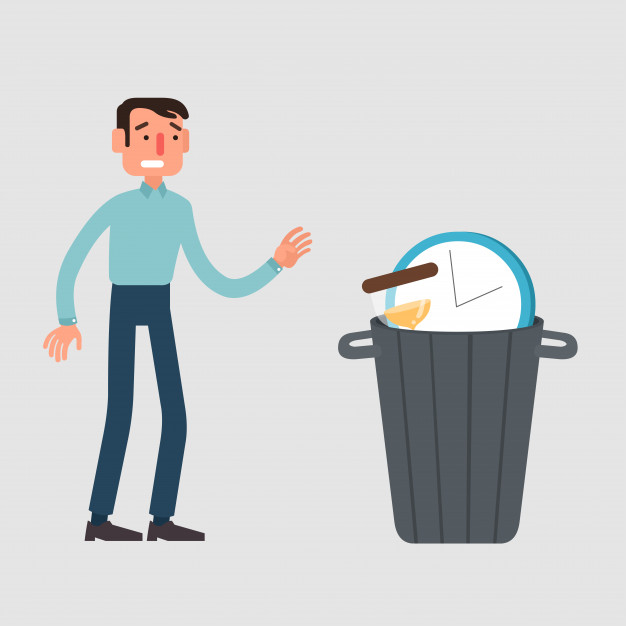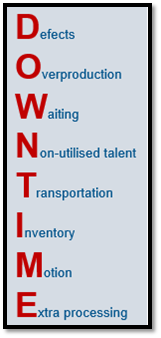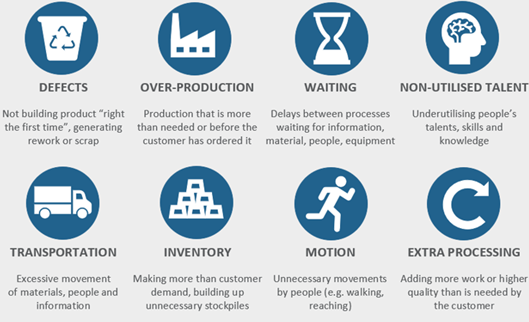Time and materials are valuable commodities, yet we waste them all of the time. The ability to see waste is a good starting point to reduce it on the manufacturing floor

Lean manufacturing and waste activity
Taiichi Ohno was a Japanese industrial engineer who created the seven wastes as part of the Toyota Production System. His methodologies have been adopted worldwide under the lean manufacturing banner and are commonly used today both within and outside the manufacturing sphere. As lean manufacturing principles and methodologies gained traction over the last few decades, an eighth waste was added; non-utilized talent. The acronym DOWNTIME is often used to remember the 8 wastes. The concept of 8 wastes is simple; identify waste activity, remove it and experience transformations in productivity across your business.
What is waste activity?
In a lean manufacturing environment, time spent gathering and collating the information is necessary, but it is also one of the 8 wastes. Therefore, spending less time gathering the data and more time acting on it is a critical part of running an effective factory floor. By using a combination of simple visual controls along with digital data, information can be communicated much more effectively and efficiently to those who need it, when they need it.

Value add versus non-value add
Every activity on the factory floor can be described as value add, non-value add or necessary non-value add. This terminology is very useful when you are reviewing processes in order to identify waste activity.
- Value add is any activity that a customer is willing to pay for, such as the assembly of components to make a product they wish to purchase
- Non- value add is any activity that does not add any value to the product, such as placing a semi-finished or finished product in a storage container in the hope that a customer will order it in the future
- Necessary non-value add is any activity that does not add value to the product but is essential to the supply of the product, such as critical inspection processes
The 8 wastes
1. Defects
When a product is not built right the first time it is classified as a defective product. If the product is discarded, then the time it took to make the product as well as the raw materials involved are classified as waste. If the defect is reworked, then this is also a waste in the form of extra time and possibly extra materials. Also, should the defective product get shipped to a customer, this will result in customer dissatisfaction or even the loss of a customer. Examples of defect waste…
- Products produced outside of specification
- Cosmetic defects that are considered unacceptable to ship to customers
- Errors in documentation that cause a delay in a process and/or the need to re-process the documentation
Well defined procedures, standardised methods to complete tasks, robust equipment and fixtures and standardised documentation templates are effective ways to control defect waste.
2. Overproduction
Overproduction is when products and materials are produced before they are required by the next downstream process. This creates excess work in process (WIP), which has many negative impacts on the factory floor…
- Storage containers and trolleys must be purchased to store the WIP
- Space must be found to store the WIP trolleys, which take up valuable manufacturing space
- Quality problems that could have been detected much earlier if the product moved on to downstream processes are instead detected when larger volumes of product are built. This results in higher scrap costs than necessary
- Over producing hides virtually every other type of waste activity by camouflaging their impact on the manufacturing floor
- Build-up of WIP awaiting access to shared equipment (due to poor planning and lack of a First In First Out process)
Production managers may be tempted to “build ahead” in order to cover up the many causes of over-production, such as:
- Unreliable processes (build as much as we can in case the process breaks down)
- Inaccurate forecast and demand information (we thought the customer needed it)
- Unpredictable production schedules (poor planning)
- Long changeover times (build in bulk to minimise batch changeovers)
Implementing pull systems, setting max WIP levels and balancing out the work content between each process step are common methods to minimise the build-up of WIP. Improving process stability is a very useful strategy to build confidence associated with unreliable processes. Stopping over production does take courage as you are, in effect, removing a safety net in order to make things more efficient.
3. Waiting
Waiting is any delay that prevents a product from moving to the next process. It includes any delay waiting for materials, information, people or equipment. Time is money and any time spent waiting for something is lost opportunity. In manual assembly manufacturing environments, this can have a ripple effect where a delay at one process eventually affects multiple other processes. This means that lost work hours can be multiples of the downtime duration (e.g. 5 people experiencing a 1 hour wait time = 5 lost hours of productivity). Waiting costs the company in terms of direct labour costs. This is exasperated if overtime is required to address the shortfall. Also, if the production operators have to “work faster” to compensate, this can result in an increase in defect waste. Common causes of waiting waste include…
- Unbalanced processes (work not evenly divided between operators)
- Quicker responses to downtime issues
- Unplanned downtime due to unreliable equipment or processes
- Long changeover times
- Production operators waiting for instructions (poor planning)
Implementing standard work and balancing the work between production operators are commonly used to minimise wait times. For example, let’s say the takt time is 60 seconds. If one operator has 60 seconds of work per cycle and the person next to them has only 40 seconds of work, the first operator is going to struggle to hit takt consistently whereas the second operator will experience a lot of wait time over the course of a production shift. Measuring and addressing the biggest causes of unplanned downtime and streamlining the changeover process are also common methods used to minimise waiting waste.
4. Non-Utilized Talent
Non-utilised talent is a unique form of waste. It is the only form of waste that is not manufacturing-process specific and is more about how management sees the people working on the manufacturing floor. When the talents of the manufacturing team are not fully utilised, this represents waste in the form of lost opportunities. This type of waste occurs when the management team fails to inspire, motivate and encourage all employees to utilise their talents to maximum effect. Examples include…
- Failure to involve all employees in improvement activity, especially production operators
- Failure to involve all employees in problem solving investigations, especially production operators
- Assigning employees to tasks without appropriate training (e.g. promoting a production operator to team lead without appropriate training)
- Poor communication of instructions to employees
This waste was added to the other seven types of waste to help incorporate employee learning and development initiatives into the overall lean manufacturing program. By engaging all employees, providing them with appropriate training and empowering them to utilise their talents fully, overall productivity and efficiency improve. In essence, eliminating this type of waste will reduce all other forms of waste..
5. Transportation
Transportation waste involves the movement of people, materials or equipment more often, or over longer distances, than necessary. Apart from the extra time involved, excess movement can lead to other types of waste such as…
- Excessive handling and damage to products
- Waiting waste when waiting for the retrieval of products or materials
- Energy waste in the form of trucks or forklifts that move products around a manufacturing facility
It is very beneficial to periodically (e.g. annually) look at the whole plant layout with a view to simplifying how products flow through the plant. Value stream mapping and plant layout models are powerful tools to help visualise what is possible before executing any changes. Once the plan is visualised, careful planning and execution will ensure that there is minimal disruption to manufacturing operations during the re-layout. Unless it’s a complete radical overhaul, it is usually possible to execute the plan on a phased basis, one section at a time. The benefits are not just seen in transportation waste reduction. Highlighting the product flow routes, or lack of, in a plant can expose other wastes such as waiting or inventory waste that can be more easily addressed once exposed
6. Inventory
Holding excess raw materials, WIP and finished goods are all forms of inventory waste. The more inventory that is held, the more money that is tied up in the business unnecessarily. This can turn into a very expensive form of waste, especially when inventory expires and needs to be written off. Furthermore, if there is excess inventory it can be difficult to find the raw materials or WIP when they are needed. Imagine buying a year’s worth of groceries in one shopping trip. How much extra storage would you need to hold everything? How much would expire? How difficult would it be to find what you need when you need it?
Common causes of inventory waste include…
- Overproduction of goods due to poor planning (more finished goods than customer demand)
- Overproduction of goods “just in case they are needed” (safety net – fear of running out)
- Purchasing excess raw materials (purchasing 2 years’ worth of inventory for a price break increases storage costs)
- Excess transportation waste (transferring inventory to other parts of the plant for storage)
There is a lot that can be done to minimise inventory waste, including…
- Defining min and max levels of raw materials and finished goods. If min and max levels are adhered to, this will indicate when to trigger a re-order or a re-build (min level reached) or when to stop ordering or building (when max level reached). Labelling storage containers and marking out spaces on the factory floor can act as visual cues if inventory reaches the max level. Another aspect of this is to stop purchasing storage containers, trolleys and racking for holding the excess inventory. Chances are there is already an abundance of storage solutions in place.
- Implementing flow between processes eliminates the need to store expensive inventory. If there is a storage area there and the principles of flow are not implemented, they will be filled with more inventory. If a product cannot flow from one process to the next (e.g. bulk loading of products into an oven), implement a FIFO (First In First Out) system instead
- Purchase raw materials only when needed (just in time). This saves the time and space of storing materials that may or may not be needed in the coming weeks and months
- Make a strategic decision not to stockpile inventory, just in case it is needed. This is a management decision that requires courage, strong will and determination
Remember that holding inventory is a safety net to avoid exposing weaknesses in the manufacturing and supply chain. Getting rid of the safety net will expose the barriers to flow, which can then be addressed one by one.
7. Motion
When people use excessive physical motion such as bending, lifting or reaching in order to complete their work, this is known as motion waste. All unnecessary motions result in extra effort and puts the body under unnecessary strain, which results in excess time to complete tasks. It also risks injury to workers. Common causes of motion waste include…
- Poor workstation layout (e.g. equipment placed out of comfortable reach)
- Shared equipment and fixturing (e.g. operators must walk to a designated area for shared equipment)
- Poor product or process design (e.g. excess movements of parts to assemble components together)
- Poor work instructions (e.g. operators create their own methods for completing tasks with excess motion)
Much of this motion waste can be removed by working with the production operators…
- Analyse how much the operator, product, materials and tools move within each individual workstation and identify opportunities to reduce each motion
- Process map each line or cell and identify opportunities to re-layout the factory floor to reduce the movement of people and products
- Implement standard work for each process that describes the sequence of steps that must be followed when carrying out a task. This eliminates operators creating their own techniques
8. Extra Processing
Extra processing is where production operators carry out tasks that are not required by the customer and do not add value to the product or service. There are many examples of extra processing waste that happen every day, including…
- Reworking products because they were not produced correctly the first time
- Storing work in process (WIP) in containers and then removing them later on for processing
- Shipping the wrong product to customers resulting in handling returns and re-shipping the correct products
- Re-sending emails or re-printing information due to missing attachments or typos
Causes of extra processing waste include…
- Poor product design or unstable manufacturing processes that produce excessive defects
- Production lines not set up to facilitate flow, resulting in storage of WIP offline
- Poor communication between departments resulting in incorrect shipments
- Not adhering to email prompts that detect typos or missing attachments
Designing products with manufacturing in mind (design for manufacture or DFM) is a very useful strategy for ensuring extra processing waste is minimised during the development of new products and processes. Also, defining the optimal workflow helps identify unnecessary process steps. Once identified, steps can be taken to remove unnecessary processes. In addition, six sigma methodologies can radically improve the stability of processes, thereby eliminating costly rework processes.

Request a free demo: Eliminating the 8 wastes is made easier when the performance of the production processes are more visible. Kt-Pulse is the first app-based product that captures data directly from the production operators in real-time, thus quantifying and visualising productivity and problem areas on easy-to-read dashboards. If you’d like to see for yourself how Kyzentree’s software, Kt-Pulse, can help you to measure productivity and quantify waste on your manufacturing floor more effectively, book a one-to-one, no obligation consultation today and we’ll showcase the benefits to you.
About Kyzentree: We are a recognised leader in improving productivity by making it easy to visualise and manage manufacturing operations. We specialise in operator-driven processes. We have brought together a team of manufacturing, lean-sigma and technology experts to bring you our flagship product Kt-Pulse™. Kt-Pulse is an app-based software solution built exclusively for monitoring any type of manual assembly, inspection or packaging process.
